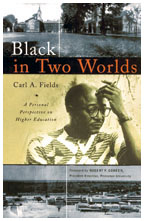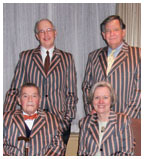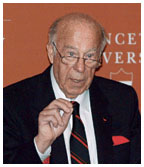
|
April 5, 2006: Notebook
Princeton’s presidents reflect on 50 years in office
Big test for Terracycle’s three generations of Tigers
University responds to filings in Robertson lawsuit
Carl Fields’ memoir: Answering Princeton’s call
Fellowships draw young alumni to Latin America
Princeton’s presidents reflect on 50 years in office
Before speaking at the Princeton Club of New York, the University’s four living presidents gathered for a photo dressed in jackets presented by the Association of Princeton Graduate Alumni. Clockwise from lower left are Robert F. Goheen ’40 *48, Harold Shapiro *64, William Bowen *58, and Shirley Tilghman. (nan melville, courtesy apga) |
Princeton University’s four living presidents live within minutes of each another, yet the quartet rarely appear together in public. Robert Goheen ’40 *48, William Bowen *58, and Harold Shapiro *64 remain busy even in retirement, and Shirley Tilghman has her hands full governing the University.
So the fifth annual Princeton Night, held March 2 at the Princeton Club of New York, was something of a historic occasion for Old Nassau. In front of nearly 250 alumni and guests, the four presidents spoke about their 50 years in office and the challenges facing Princeton in the years ahead.
Many alumni were decked out in orange-and-black jackets for the occasion, and they greeted the guests of honor with jovial affection. The most enthusiastic applause was reserved for Goheen, who served as president from 1957 to 1972. Bent slightly with age, Goheen ascended gingerly to the dais in the club dining room. When he reached the microphone, he had to raise his hand to silence the alumni, who had risen to their feet to greet him.
In his remarks, Goheen took a few jabs at the Concerned Alumni of Princeton, the defunct group that made headlines during the confirmation hearings of Samuel A. Alito Jr. ’72 for a seat on the U.S. Supreme Court.
“In the 1960s and 1970s, there were those of our fellow alumni who were vehemently opposed to racial integration and coeducation,” Goheen said. “I regretted that some of my classmates, indeed some of my clubmates, were among them.” (Bowen later took his own shot at the group, saying: “I did take some satisfaction in the demise of the organization.”)
Goheen also heaped praise on his successors for their achievements: He commended Bowen for creating the undergraduate colleges, Shapiro for emphasizing the importance of undergraduate education and building the Frist Campus Center, and Tilghman for helping to raise $101 million for the arts at Princeton. (The gift came from Peter B. Lewis ’55.)
Goheen was followed by Tilghman, who shared a winning anecdote about her relationship with Princeton’s former presidents. Whenever she needs advice, she said, she simply takes her dog for a walk. Within five minutes, she can visit “Bob or Harold or Bill’s” house to seek their counsel. Being president was that much easier, Tilghman said, because she was “standing on the shoulders of giants.”
Bowen, who served as president from 1972 to 1988, was perhaps the most provocative speaker of the night. Like the others, he thanked the alumni and his Princeton colleagues for their support. Referring to the “recent turmoil at Harvard” — Lawrence Summers’ resignation as president — Bowen commended Princeton for its “highly collegial” and “mutually supporting” atmosphere.
Yet Bowen also cautioned the University against becoming complacent. “It’s easy to spend so much time patting yourself on your back that you fail to move forward,” he said. “That’s disastrous.” Bowen argued that Princeton and other universities need to do a better job drawing students from lower socioeconomic groups. “We all have a lot of work to do,” he said.
The evening concluded on a lighter note when Shapiro, who left office
in 2001, confessed to a few missteps during his presidency. It was a mistake,
he admitted, to ban beer kegs on campus. Ditto for proposing to eliminate
the men’s wrestling team. The crowd’s good-natured laughs
turned to hisses, however, when Shapiro defended his decision to ban the
Nude Olympics. Apparently, all is not forgiven. ![]()
By Maurice Timothy Reidy ’97

Big test for Terracycle’s three generations of Tigers
Terracycle co-founders Thomas Szaky ’05 and Jon Beyer ’05, surrounded by bottles waiting to be filled with the company’s organic plant food. |
In a rundown warehouse in the heart of Trenton’s old industrial area, several Princeton alumni have set up shop for an upstart fertilizer company, Terracycle Inc. The brick building — marked by graffiti and metal window grates — is an unlikely location for a new company to thrive. But for Terra-cycle CEO Tom Szaky ’05, the warehouse and its secondhand furnishings are emblematic of the company’s ethos.
“The whole idea behind Terracycle is that we try to leverage the things that people see no value in,” Szaky said.
Terracycle’s featured product is a testimony to Szaky’s ideals of ecocapitalism: The company manufactures organic plant food made from worm excrement and packages the fertilizer — a clear, odorless yellow liquid — in used plastic soda bottles. Terracycle aims to challenge other big players in the gardening industry with a plant food that is environmentally friendly and competitively priced.
After selling its products in Wal-Mart and Home Depot stores in Canada last year, Terracycle will go up against well-known brands like Miracle-Gro in the chains’ American stores nationwide this year. With 400,000 bottles of plant food shipped out for initial orders, 2006 will be Terracycle’s first opportunity to turn a profit. According to Szaky, sales are projected to reach $2.2 million.
“This is the critical moment after three or four years of work,” Szaky said. “We are doing everything we can, but ultimately it just comes down to people and whether or not they are going to buy it.”
This is the first time the company’s future has been out of Szaky’s hands since its creation in 2002. At that point, Szaky was a rising sophomore at Princeton, and he and co-founder Jon Beyer ’05 had entered the idea for Terracycle into the annual Princeton Business Plan Contest. Though their fourth-place finish did not garner any prize money, Szaky and Beyer cashed out their personal savings and maxed out their credit cards to continue their research on worms and waste. They worked with garbage from University dining halls, learning how to use red worms to convert trash into plant food.
In 2003, Szaky dropped out of Princeton to devote more time to Terracycle. He put together an eclectic group of executives, academics, and investors to guide the company’s growth. Through TigerNet and alumni contacts, Szaky persuaded Tom Pyle ’76, Royce Flippin ’56, and Rick Ober ’65 to join Terracycle’s team.
As board chairman, Pyle works closely with Szaky, despite an age difference of nearly 30 years. Pyle — affectionately nicknamed “The Principal” by his younger co-workers — maintains that part of Terracycle’s success stems from the company’s blend of intergenerational skills.
“At Terracycle, we link up corporate-type executives with youthful
energy,” Pyle said. “We have different ways of looking at
problems and different levels of experience. In some sense, we represent
three generations of Princetonians.” The result, he added, is “a
hell of a lot of fun.” ![]()
By Allison Berliner ’06

(Photo by Beverly Schaefer) |
“Radical Islamists cannot function without a surrounding population of acquiescence. The effort to dry up the sea of support of terrorists — this is the mission. ... The Middle East is the world’s center of conspiracy theories. If we are candid and open and factually correct, we have a platform to counter this delusional talk.”
Former secretary of state George P. Shultz ’42 discussing the
war on terror during a talk March 15 in McCosh 50.
![]()

University responds to filings in Robertson lawsuit
In a sharply worded response to recent filings in the Robertson family’s lawsuit against Princeton, the University defended its stewardship of the Robertson Foundation’s assets and said it has advanced the foundation’s mission. Princeton denied the family’s allegations of overcharging, maintaining it had “undercharged” the foundation by $235 million.
The University also took aim at William S. Robertson ’72, a foundation trustee and son of the late Charles Robertson ’26 and his wife, Marie, who donated $35 million to set up the Robertson Foundation in 1961 to support the graduate program of the Woodrow Wilson School in preparing students for government service.
Citing William Robertson’s statements that he will never support or work with the University, and asserting that he has “raided” a separate foundation controlled by him and his siblings to pay for the lawsuit, the University said Robertson is “no longer qualified to serve” as a Robertson Foundation trustee. Peter McDonough, general counsel for the University, said in an interview that a court may be asked to rule on the issue in the future, but only “as a last resort.”
Robertson family members sued the University in 2002, saying Princeton has failed to carry out the intended purpose of the gift and that $207 million has been spent inappropriately. The suit seeks to end the University’s ties to the foundation, whose assets are valued at $650 million.
In legal papers filed March 13, the University maintains:
• Some expenditures that legally could have been billed to the foundation were paid with University — not foundation — funds. The largest of these — $210 million — resulted from charging the foundation only for the expansion of the Wilson School’s graduate program and not for the cost of maintaining the pre-existing program. Princeton said the foundation’s incorporation papers legally allow the foundation to be charged for the “base-year” costs of the program as well. The University said it has no intention of seeking to recoup the funds.
• A three-year fellowship program to support graduate students in departments outside the Wilson School — the subject of extensive press coverage in February — was paid for entirely by income from other endowments. The Robertson family claims that the fellowships were improperly charged to the foundation and that President Tilghman had not been forthcoming about funding for them — assertions strongly denied by the University. According to Princeton, Tilghman was not aware of the funding source at the time she was questioned about it.
• A number of “significant mission-enhancing initiatives” have been undertaken by Anne-Marie Slaughter ’80, dean of the Wilson School, and a number of governance initiatives were introduced by Tilghman, who is foundation president.
• According to a September 2005 survey, 40 percent of first jobs held by graduate alumni were in the government and the military, 17 percent in the private sector, 14 percent with nonprofits, and 10 percent with international NGOs. “I am proud to match our placement records with any other public policy school,” Slaughter said. The Robertson family says that the school does not send enough graduates into government service in international relations, a primary interest of the donors.
William Robertson, referring to Princeton’s position that it could have billed the foundation for the full cost of the graduate program and not just its expansion, said former presidents Robert F. Goheen ’40 *48 and William Bowen *58 had made promises to the contrary. He added: “It is a sad day for philanthropy in America ... and for Princeton, when the University is forced to tell the world that its word is not its bond.”
Both sides are seeking to resolve key issues before trial in New Jersey
Superior Court. ![]()
By W.R.O.

Carl Fields’ memoir: Answering Princeton’s call
 |
When Carl A. Fields received a call asking if he was interested in becoming Princeton’s first black administrator, he almost hung up. Half asleep when the phone rang in December 1963, Fields had a hard time believing that Princeton would hire “a black guy to do anything more than keep the grass cut or serve food,” he wrote in his memoir, Black in Two Worlds.
Posthumously published by Hummingbird Press in February, Fields’ book recounts his initial reluctance to work at Princeton — an institution, he writes, that “reeked of a solid white American history of denial of the real worth or ability of the black” and that had just 12 black undergraduates and four black graduate students. But Fields was hired as assistant director of student aid, and in 1968 he was promoted to assistant dean of the college.
In the first part of the book, Fields brings the reader through his trials and triumphs as Princeton’s first black administrator, from 1964 to 1971. (For an excerpt first published in PAW in 1977, click here.) In the second part of his memoir, Fields describes his experiences as the first black American planning officer in an African university, at the fledgling University of Zambia from 1971 to 1974. Fields died in 1998.
Hired to help Princeton attract and keep African-American students, Fields began to build a community of black students and helped develop ties with members of the black community. His family-sponsor plan — he had to convince faculty members and deans of its merits — matched up black students with local families who could provide the support needed to survive at the mostly white campus. The retention rate of black students was 98 percent in 1968. “My office,” he writes, “had by now become the unofficial headquarters and meeting place for the black students.”
Fields also recalls how he helped form the campus’s first African-American student group. And he was the driving force behind the Third World Center, renamed the Carl A. Fields Center for Equality and Cultural Understanding in 2002.
In the book’s preface, Robert F. Goheen ’40 *48, president
of Princeton during Fields’ tenure, credits Fields with helping
to create an atmosphere more comfortable for all students. “From
almost the moment of his arrival,” writes Goheen, Fields helped
African-American students “maintain their self-esteem and cope more
readily with the often unfamiliar, academically intense, socially very
white environment in which they found themselves immersed.” ![]()
By K.F.G.

Fellowships draw young alumni to Latin America
Alex Leader ’03, pictured during her 2003–04 Princeton in Latin America fellowship, worked with young musicians in Bolivia. PiLA plans to award 10 fellowships this spring. (courtesy PiLA) |
On a Sunday night in November, a few months after starting his yearlong Princeton in Latin America (PiLA) fellowship with Human Rights Watch in Santiago, Chile, Adam Abelson ’05 answered the phone call that would redefine his experience. “My boss called me, out of breath, saying, ‘You’re not going to believe this, but Fujimori is in the Marriott,’” Abelson recalled.
In November and December, after Alberto Fujimori, the former Peruvian president, ended his five-year exile in Japan and mysteriously turned up in the Chilean capital, Abelson and his colleagues collected documents and spoke with lawyers as they prepared a report recommending Fujimori’s extradition to Peru to stand trial on charges that included authorizing the murder of political opponents and diverting government funds. (As of early March, Fujimori remained in the custody of Chilean authorities.)
“It’s been fascinating, intellectually stimulating, and rewarding,” said Abelson, who plans to pursue international law, “not just in terms of the excitement of the daily job, but meaningful in the broader sense, knowing that you’re actually contributing to the state of human rights.”
Abelson is one of 17 young alumni to receive a PiLA fellowship since the program began in 2003, and while not all have been firsthand witnesses to history, several consider their fellowships to be equally valuable. The program’s popularity has grown, according to Christian Gomez ’03, one of the first two PiLA fellows and now the program’s executive director. Applications jumped from 40 to 55 in the last year, and PiLA plans to award 10 service fellowships this spring.
Still, PiLA offers fewer fellowships than the 20 given last year by Princeton in Africa, founded in 2000, or the 90 fellows sponsored by the longstanding Princeton in Asia program, which supports graduates from other colleges as well. Gomez, who doubles as an assistant coach for Princeton’s perpetually overmatched sprint football team, joked that he’s “used to being the underdog.” In an effort to help PiLA grow, he has aggressively pursued private donations, moving beyond the University funding sources that helped the independent nonprofit at its start.
Beyond financial resources, PiLA’s success relies on its bonds with the Program in Latin American Studies, one of the University’s most popular certificate programs, and the extensive experience that many recent graduates bring to their fellowships. Alex Leader ’03, for example, had completed internships and thesis research in the Dominican Republic, Cuba, Ecuador, and Chile before beginning her 2003–04 PiLA fellowship giving cello lessons to youth orchestra members in the eastern lowlands of Bolivia. As a student at Mount Sinai School of Medicine, Leader has continued her commitment to Latin America: She returned to Bolivia last summer as a health care volunteer.
PiLA also has developed a niche by seeking out students interested in
nontraditional career paths, in fields such as world health and development.
Elyse Kovalsky ’03 served as a reproductive and sexual health educator
in El Alto, Bolivia, near the capital city of La Paz, during her fellowship.
Encouraging women to overcome their apprehension and ask questions about
health issues like menopause proved challenging, but the field experience
was invaluable, according to Kovalsky, who now administers AIDS education
and community health programs for the Academy for Educational Development,
a Washington, D.C.-based nonprofit that funds education and health initiatives
domestically and in developing countries. “It’s what motivates
me,” she said. “If I didn’t have that kind of experience
to back me up, I would not attach the same importance to this work, and
it wouldn’t be inspiring to me in the same way.” ![]()
By B.T.

© 2006 Andy Warhol Foundation for the Visual Arts / Artists Rights Society (ARS), New York |
“ANDY WARHOL: ELECTRIC CHAIR” is the title of an exhibition of 10 prints on display through June 25 at the University Art Museum. The prints, created in 1971, demonstrate Warhol’s sustained interest in mortality, which was likely rekindled by his near-fatal shooting in 1968, said exhibition organizer Alex Kitnick, Ph.D. candidate in the Department of Art and Archaeology. The brightly colored images were produced by pressing ink with a squeegee through a fabric screen.
The inventor of the World Wide Web, TIM BERNERS-LEE, will speak Wednesday, April 5, at 8 p.m. in McCosh 50 as part of the University Public Lecture series. Berners-Lee is the director of the World Wide Web Consortium and is senior researcher at MIT’s Computer Science and Artificial Intelligence Laboratory.
TERDEMA USSERY ’81, president and CEO of the Dallas Mavericks of the NBA, will speak Thursday, April 6, at 4:30 p.m. in McCosh 28. Ussery is also CEO of HDNet, the nation’s first high-definition television network. His talk is part of the Black Princeton Alumni Speaker Series.
“SCHOOL SHOOTINGS: WHY TERRIBLE THINGS HAPPEN IN ‘PERFECT’ PLACES” will be the subject of a President’s Lecture by professor Katherine Newman Monday, April 10, at 4:30 p.m. in Friend Center 101. Newman is the Malcolm S. Forbes ’41 Professor of Sociology and Public Affairs.
The Fund for Irish Studies is sponsoring a SAMUEL BECKETT CENTENARY
SYMPOSIUM Friday, April 14, at the Stewart Film Theater at 185
Nassau St. It begins at 2:30 p.m. with an illustrated talk by photographer
John Minihan, followed by programs featuring professors from Princeton
and other colleges. At 8 p.m. Sean O’Mordha will introduce a screening
of his documentary, “Samuel Beckett: Silence to Silence.”
![]()

Illustration: Steven Veach |
High tide
Rising seas could have serious economic and environmental consequences
for New Jersey in the next 100 years, according to a report by Professor
Michael Oppenheimer, Matthew Cooper ’05, and Michael Beevers, a
graduate student at the University of Maryland. Using global and regional
models for sea-level rise and elevation data from the U.S. Geographical
Survey, the study predicted that a sea-level rise of two feet in the next
100 years (a 50 percent probability) would mean a loss of approximately
170 square kilometers or nearly 1 percent of the state’s total land
area; a more severe rise of four feet (a 1 percent probability) would
drown more than three times as much land and threaten the habitats of
several endangered species. A changing coastline also would affect tourism,
shipping, and commercial fishing. The high value of coastal properties
could make beach replenishment worthwhile in the short term, but according
to the authors, a “gradual withdrawal of development from the coast”
may be the most cost-effective long-term plan. ![]()

Former astronaut DAN BARRY *80, a veteran of three space shuttle missions, took on a terrestrial challenge as a contestant on Survivor: Panama — Exile Island, the latest edition of the reality TV series. Barry, who earned his Ph.D. in electrical engineering and computer science, survived six weeks on the show before being voted off by his peers in an episode that aired March 9.
GRADUATE SCHOOL Dean William B. Russel announced a new “Dissertation Completion Enrollment” (DCE) program for Ph.D. students who do not finish their doctoral work within the four or five years allotted by their departments. For a discounted annual tuition of $3,500 and a $1,000 student health plan fee, Ph.D. candidates may maintain student status for up to two years.
The program will replace “Degree Candidacy Continuing” (DCC) status, a one-year designation created in 2002 to enable students to maintain visa eligibility and defer student loans. In addition to the visa and loan benefits, the DCE program will permit students to keep health benefits and enter the graduate housing draw. Russel said that about half of the students eventually entered DCC status, but only one-third to one-half completed their dissertations during the one-year period.
Five Princeton seniors are among 40 U.S. winners of GATES CAMBRIDGE SCHOLARSHIPS to study at the University of Cambridge. Sara Asrat, from Buffalo, N.Y., is a history major and candidate for a certificate in European cultural studies. She is a member of Sustained Dialogue, a group working to improve race relations at Princeton. She plans to study modern European history at Cambridge.
Suneel Bhat, an ecology and evolutionary biology major from Clarksville, Md., plans to study epidemiology. In the summer of 2004 he oversaw construction of a nursery school and conducted research in a rural village in India. Christopher Bohn, a chemical engineering major from Monument, Colo., is a candidate for certificates in finance and bioengineering. He will continue his chemical engineering studies. He was an editor and Web site manager for Business Today and performed with a breakdancing group.
Kara Gaston, an English major from Mariaville, Maine, is pursuing a
certificate in medieval studies and plans to study medieval and Renaissance
literature. A track and cross-country athlete, she was recognized for
the best junior paper in English. Daniel Greco, from New York City, is
a philosophy major who plans to continue philosophy studies. He received
the Shapiro Prize for Academic Excellence.![]()






